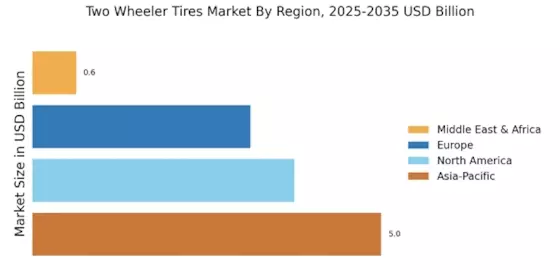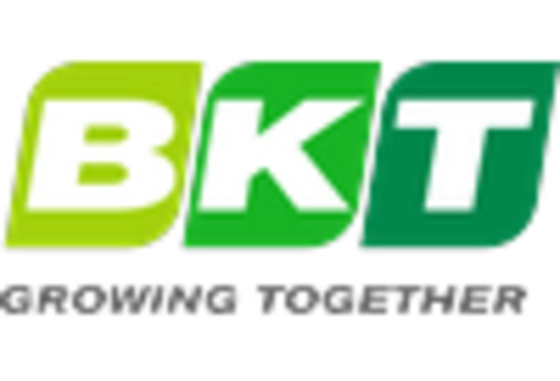Growth of E-commerce and Delivery Services
The expansion of e-commerce and delivery services is emerging as a significant driver for the Two Wheeler Tires Market. With the rise of online shopping, there is a corresponding increase in the demand for delivery vehicles, particularly two-wheelers, which are favored for their agility and ability to navigate through traffic. This trend is particularly pronounced in urban areas where quick delivery times are essential. As a result, logistics companies are increasingly investing in two-wheeler fleets, thereby boosting the demand for two wheeler tires. Recent statistics suggest that the e-commerce sector has grown by over 20% in various regions, leading to a surge in the need for reliable and durable tires that can withstand the rigors of frequent use. This growth trajectory is likely to continue, further stimulating the tire market.
Rising Demand for Efficient Transportation
The increasing need for efficient and cost-effective transportation solutions is a primary driver for the Two Wheeler Tires Market. As urbanization accelerates, more individuals are opting for two-wheelers due to their affordability and convenience. In many regions, two-wheelers are seen as a practical alternative to cars, especially in congested urban areas. This shift in consumer preference is reflected in the growing sales of two-wheelers, which have seen a steady increase over the past few years. According to recent data, the two-wheeler segment has experienced a compound annual growth rate of approximately 6% in various markets. This trend is likely to continue, further propelling the demand for two wheeler tires, as manufacturers strive to meet the needs of an expanding customer base.
Technological Innovations in Tire Manufacturing
Technological advancements in tire manufacturing are significantly influencing the Two Wheeler Tires Market. Innovations such as improved rubber compounds, advanced tread designs, and enhanced manufacturing processes are leading to the production of tires that offer better performance, durability, and safety. For instance, the introduction of smart tires equipped with sensors that monitor tire pressure and temperature is gaining traction. These innovations not only enhance the riding experience but also contribute to fuel efficiency and reduced emissions. As consumers become more aware of the benefits of these technologies, the demand for high-performance two wheeler tires is expected to rise. Market data indicates that the segment of high-tech tires is projected to grow at a rate of 8% annually, reflecting the increasing consumer preference for technologically advanced products.
Focus on Fuel Efficiency and Environmental Concerns
The growing emphasis on fuel efficiency and environmental sustainability is a crucial driver for the Two Wheeler Tires Market. As consumers become more environmentally conscious, there is a rising demand for tires that not only enhance fuel economy but also reduce carbon footprints. Manufacturers are responding to this trend by developing eco-friendly tire options that utilize sustainable materials and innovative designs aimed at minimizing rolling resistance. Market analysis indicates that the segment of eco-friendly tires is expected to witness a growth rate of approximately 7% over the next few years. This shift towards sustainability is not only beneficial for the environment but also aligns with regulatory pressures aimed at reducing emissions, thereby creating a favorable market environment for two wheeler tires that meet these criteria.
Increasing Investment in Infrastructure Development
The surge in infrastructure development projects is likely to serve as a significant driver for the Two Wheeler Tires Market. Governments and private sectors are investing heavily in road construction and improvement, which enhances the overall transportation network. Improved road conditions facilitate safer and more efficient travel for two-wheelers, thereby encouraging more individuals to adopt this mode of transport. As infrastructure continues to develop, the demand for two wheeler tires is expected to rise correspondingly. Recent reports indicate that infrastructure spending has increased by approximately 15% in various regions, which is anticipated to have a direct positive impact on the two wheeler market. This trend suggests a robust future for the tire industry as more consumers take to the roads.


















Leave a Comment